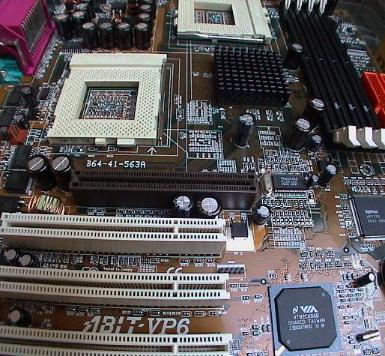|


This was probably the most highly-anticipated motherboard of 2000. I
had been waiting for it since Autumn 1999, when I heard that Intel was
changing its Celerons from PPGA to FCPGA and that my ABIT BP6 had reached
the end of its road. Certainly the BP6 had created a whole new subculture
of SMP fanatics like me; it was the first time dual processing had ever
entered into our price range, and once we'd tasted dual goodness, it was
tough to go back.
For the uninitiated, here's a little background: SMP stands for
Simultaneous MultiProcessing, which allows you to distribute your
computer's workload between more than one CPU. It does not mean that it
will operate twice as fast. Rather, you get the utmost in stability, and
you get to open about a gazillion windows with CPU-intensive applications
without having to worry about system hangs or BSODs. (Or should that be
BSes of D?)
The BP6 was revolutionary in that it gave us the chance to set up dual
systems with the then super-cheap and super-overclockable Celeorns. But
Intel had never intended to make SMP available for the mainstream "enthusiast"
market. If you wanted to cough up for dual Xeons and an i840-based server
board, that was fine. The last thing they wanted was a low cost SMP
solution cutting into that market. Indeed, Intel had even announced that
Celerons could not be made to work dually. Thankfully, the engineers at
ABIT demonstrated that this was not the case, and SMP hit the mainstream.
So here we are a year or so later. Celeron 2s actually have been
SMP-disabled, and the dual Socket A 760MP chipset from AMD has not arrived
yet. (Rumors have it that when it does arrive, it will only be in an
expensive, 6-layer "Extended ATX" form factor.) That leaves us
with Pentium IIIs. The "DP" revision of VIA's 694X chipset
provides SMP support for PIIIs, and there has been a rash of motherboards
based on this chipset on the market. The ABIT VP6 is one such motherboard.
A truly tempting piece of hardware, let's see if it lives up to
expectations…
One quick note before we start: Windows9X/ME can't make use of dual CPUs.
You're going to have to switch to Windows NT/2000, Linux, or Free BeOS.
For this review, I'm using Windows 2000 Professional.
Copyright
liegt bei All-About-PC. Alle Rechte vorbehalten.
Alle Information auf dieser Website durch All-About-PC
urheberrechtlich geschützt. Reproduktion und Vertrieb in jeglicher
Form ohne Zustimmung der Redaktion sind verboten.
Wiewohl alle Informationen auf dieser Website streng recherchiert
und weitestgehend durch Sekundärquellen gegengeprüft und bestätigt
werden, kann für den Inhalt und daraus etwaig entstehenden Schaden
keine Verantwortung übernommen werden. |
|


